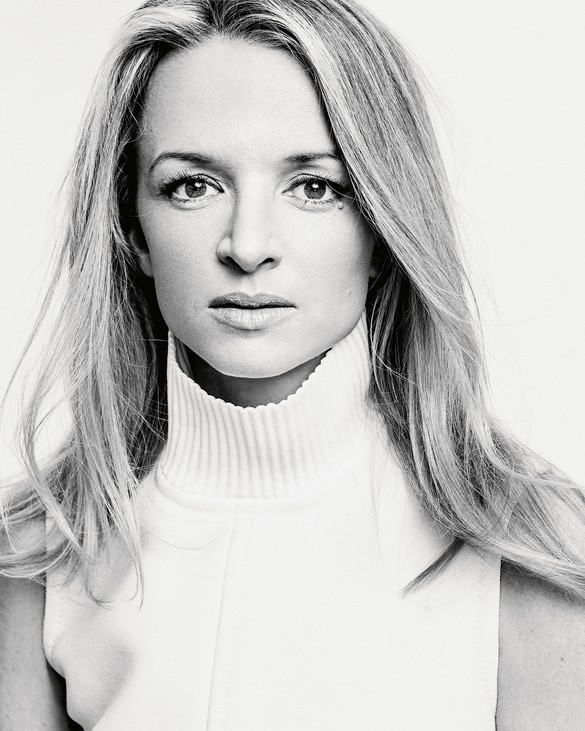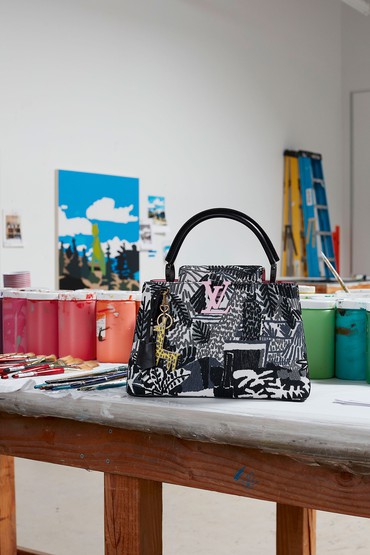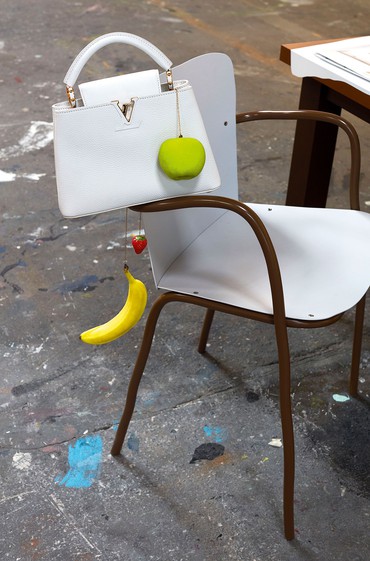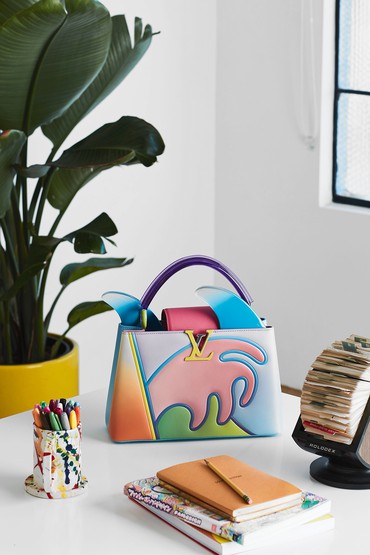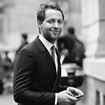
Derek Blasberg is a writer, fashion editor, and New York Times best-selling author. He has been with Gagosian since 2014, and is currently the executive editor of Gagosian Quarterly.
Louis Vuitton has a long history with contemporary artists. Stephen Sprouse, who graffitied the brand’s iconic monogram in 2001, kicked off two decades of partnerships with the likes of Yayoi Kusama, Takashi Murakami, Richard Prince, Cindy Sherman, and more. In 2019, the brand introduced the Artycapucines, giving artists such as Sam Falls, Urs Fischer, Nicholas Hlobo, Alex Israel, Tschabalala Self, and Jonas Wood carte blanche to rework its Capucines handbag. (The name comes from the rue Neuve des Capucines, the Paris street where the house opened its first store, in 1854.) This year, Delphine Arnault, the executive vice president of Louis Vuitton, announced the second Artycapucines series, inviting Liu Wei, Beatriz Milhazes, Jean-Michel Othoniel, Josh Smith, Henry Taylor, and Zhao Zhao to design their own version of the iconic handbag. Derek Blasberg spoke to Arnault about Louis Vuitton’s connection to the art world, and what she’s looking for in collecting contemporary art and accessories.
Derek BlasbergMy first question is a practical one: These bags are works of art. Do people actually use them?
Delphine ArnaultYes! But I imagine they use them very . . . cautiously. And like a work of art, over time they will become more precious. We only produce 200 of each bag, and they’re all numbered, so there’s a rarity to each one. I love seeing a woman carrying one of the bags; it’s incredible to see them in the real world.
DBIf there are six artists and 200 of each are made, there are only 1,200 bags in each series.
DAYes, and they were nearly all sold out before they even hit the stores. Many collectors know Louis Vuitton regularly works with amazing contemporary artists. Some will buy bags by all six artists, or maybe they’re a collector of one of the artists and want to be able to have their work in their daily lives, as opposed to just in their homes.
DBOf course this isn’t the first time Vuitton has collaborated in the contemporary art space. Was Stephen Sprouse the first artist collaboration?
DAActually, Vuitton’s history with art goes back much farther. The first person who started working with artists was Gaston-Louis Vuitton, who was the grandson of Louis Vuitton. He began in the first part of the twentieth century by working with different artists on perfume bottles, advertising campaigns, and window displays. In many ways he was ahead of his time. Many years later, Marc Jacobs had a huge influence on bringing contemporary artists to Vuitton, including Sprouse, Prince, Murakami, Kusama, and others. Marc is an important collector and has an amazing eye, which he brought to Vuitton, creating an incredible new link to the world of contemporary art.
DBHave any of the collaborations surprised you? Has anyone done something that made you think, Wow, I did not see that coming?
DAI remember the first time I saw the Sprouse graffiti, the monogrammed luggage with the scribbling on it, I thought, Wow! I hadn’t known what to expect and it was very striking.
DBWere you shocked that the monogram had been defaced, or did you think it was cool?
DAI thought it was super cool. I also thought that it was so new and so different from what I’d seen before. It was a big surprise. I also remember how hard it was to get the bags when they came out.
DBEven for you?
DAActually, yes! At the time, I was working at Dior, and I remember the day John Galliano came in with one of the Sprouse bags and we all thought it was such a cool product.
DBThe other iconic collaboration we saw a lot of in 2020, as masks became a required fashion accessory and health-care workers became such heroes, was Marc’s nurses collection, done in collaboration with Richard Prince for Spring/Summer 2008.
DAI thought that was amazing too. I remember sitting in the audience at that show and thinking we were witnessing a special moment.
DBI still have one of Prince’s Louis Vuitton bags from that show. I never used it, though, because I thought it was too special. I know I’m not as cautious as I should be with these bags.
DAIt’s good that you kept it because it’s very much a collector’s item now.
DBHow do you select the artists for the Artycapucines collaborations?
DAThe House is constantly in ongoing conversation with people in the art world, including artists, advisors, and other people who inform our process. We try to find artists who represent the art world today and have a strong point of view. Another key factor is that they’re from all over the world. In this second wave we have artists from France, America, Brazil, and two artists from China.
DBDo you impose any limits on the artists? I remember in the first series, Urs Fischer had a small banana that hung from the bottom of the bag.
DAUrs came up with an apple, a banana, and a strawberry, which I thought was fun and fantastic. We give the artists carte blanche. They can do whatever they want, which is important for us because we like to see an artist’s entire interpretation. Even if that means adding a banana.
DBWhat’s the design process? Do they submit a sketch? Do they come to Paris and meet with the team?
DAIt’s different for every artist and it becomes an ongoing creative process. Our designers can go see artists in their studios or artists can come see us in Paris. The artists send us drawings and then we work in our atelier to execute them. We send samples and we modify colors, textures, all the elements that make the bag unique. As you know, artists like to be very precise. This project really helped us to push our boundaries further and challenge ourselves, as we had to find new ways to master new techniques and materials. The Artycapucines collaborations are the encounter between the artistic vision of the talents we work with and the expert savoir faire of the Louis Vuitton craftsmen.
DBHow long from start to finish does it take to create a bag?
DAApproximately from three to six months.
DBYour family are huge patrons of the arts. Look no further than the Fondation Louis Vuitton. When you’re looking at artists, is your process similar for both your collecting and these collaborations?
DAWe try to work with artists who are attracted to the product and have an affinity for the brand. Cindy Sherman, for example, has always been attracted to fashion, and style is an important element in her work. We were excited to work with her because we felt that she would enjoy the process.
DBI know that the Fondation had an incredible retrospective of Cindy’s, which I was so sad to miss due to covid restrictions.
DAThe show was incredible, especially for someone like you, who works in the fashion world. Many artists are interested in fashion, by the way. Frank Gehry, for example, is very interested in fashion, and working with him was incredible.
DBI remember his bag! It was a twisted shape.
DAExactly. He said, “Okay, I want to do a bag but it can only have one straight line.” And we thought, Well, that’ll be a challenge. But the craftsmen did it and it was an incredible final design. A big component in this process is to have a lot of imagination.
DBI know this will be a hard question for you to answer: What’s your favorite bag?
DAOh, no, I can’t answer that. But I can tell you which one is the favorite of my son.
DBOK!
DAHe’s four years old and when I go out he will often say to me, “Wait, let me choose your bag.” And each time he comes up with the Alex Israel bag, from the first Artycapucines series. He loves that one the most.
DBOf course he does! It has a comb in the shape of a shark fin.
DAEach time, he says, “Mommy, you can’t leave without that bag.” And I say OK, even if it doesn’t go with what I’m wearing that day.
DBWhich bag from the second series is your son’s favorite?
DAThe one by Jean-Michel Othoniel, which has these large black-glass pearls.
DBIs there a different process between picking art for your wall and picking art for your collaborations?
DAIt’s very different. When you pick art for Vuitton, you try to find a good match between the artist and the heritage of the brand. I think it’s interesting to work with contemporary artists who are of this generation, and to get their view. They come from all over the globe and I appreciate having their view on what’s happening in the world and how it relates to their work.
DBWhat will the next series of Artycapucines look like?
DAAfter the moment of a pandemic, or a war, or other difficult moments, creativity always comes in high. I’m very interested to see what’s going to come after this and how artists are going to relate to it in their work. Look at Christian Dior: he created his brand and the New Look in 1947, just after World War II. There are always a lot of creative things happening after very difficult moments.
All images courtesy Louis Vuitton
